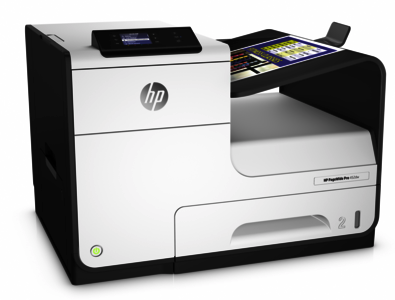
In the age of smartphones and tablets, printers may seem oh-so 20th century, but they still have their place.

Many people still circulate documents and there are those labels you need to print when you return something you bought online. For some reason, I’m more likely to find typos in my draft articles if I read them on paper rather than on screen and there are plenty of other reasons to print including — strange as it seems — letters you send by snail mail, pictures, calendars and other nice looking paper things that you might want to send people during the holidays.
I’ve recently been testing out HP’s new color PageWide Pro 452w. At $499, it’s expensive as far as printers go, but it’s really fast and economical to use. I’ve noticed over the years that lower cost printers are often more expensive to use so, whatever you pay for a printer, check out the cost of supplies before you buy it.
HP’s PageWide printers are interesting in that, as the HP website says, “Not inkjet. Not laser.” The technology, according to HP, employs thousands of tiny nozzles “on a stationary printhead that spans the width of a page” to deliver four colors of ink.
Unlike traditional ink jet printers, the paper moves past the nozzles rather than the other way around. The result is very fast printing (the unit I’m testing is rated at 40 pages per minute (ppm) but they have models that print as many as 70 ppm. It quickly spits out double sided sheets in one pass rather than the much slower two-pass method employed by most printers.
The quality is close to laser but not quite. I printed a number of different jobs ranging from a standard letter to a graphic laden brochure and, while all looked good, the brochure was not as crisp as one I printed on an HP laser printer. Still, the PageWide was more than adequate for office communications, letters and print-outs that you would want to share with others. Both text and images are clear. But, because it uses wet ink rather than dry toner like laser printers, there the possibility of smudging if you handle a graphic heavy page when before it dries or if the page gets wet.
The best thing about these printers is the cost of ink. If you buy high capacity cartridges directly from HP (they can be cheaper elsewhere), black pages will cost about 1.4 cents each and color about 1.9 cents based on an industry standard coverage. Your cost per page will vary depending upon how much ink your page uses but cost per page is about half of what you’d pay to use an HP color laser printer and much cheaper than most (but not all) ink jet printers on the market.
If you’re looking for a really low cost per page, consider any of the Epson printers that use its EcoTank ink. This ink comes in bottles rather than cartridges and a $19 bottle can yield as many as 6,500 pages. That’s about a 10th of the cost per page of even the most economical laser printer on the market.
Although either of these printers can be used to print color photos, neither is as good as printers designed for that purpose. But I’ve long stopped printing my own pictures. I find it’s cheaper and better to send them to Walgreens, Costco or some other printing service, which delivers better quality prints for less than it typically costs for paper and ink. And, if they mess up, it’s on them — not me.
Either way, it’s so much cheaper than professional printing that you can pay for the printer and extra toner after just a few hundred pages. I wouldn’t use this for large jobs, but it’s great when need to print out a couple of hundred copies at a time, which also means we can keep our brochure up-to-date because we don’t have to keep large quantities on hand.
But, despite the need for printing, it’s worth remembering that there is an environmental cost of paper, ink and even the manufacturing and recycling of the printer itself so, whenever possible, I try avoid printing when I can. And, when I print for my own use, I try to use draft mode that uses less ink. I also save money and the help the environment by using inexpensive recycled paper rather than more expensive paper sold by the printer maker.